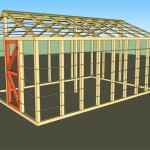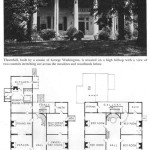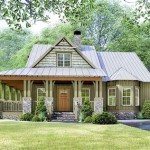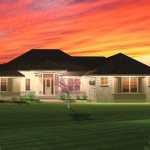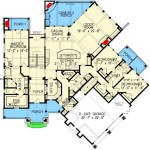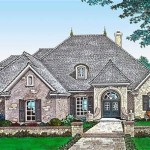Prairie House Plans are architectural designs that evoke the distinct characteristics of the American prairie style, a style that emerged in the late 19th and early 20th centuries. Characterized by their low-slung profiles, expansive horizontal lines, and integration with the surrounding landscape, Prairie Houses are known for their emphasis on functionality and simplicity. An iconic example of a Prairie House is Frank Lloyd Wright’s Robie House in Chicago, Illinois, which exemplifies the style’s blend of organic forms and geometric elements.
Prairie House Plans have gained enduring popularity due to their timeless aesthetic, energy efficiency, and suitability for various terrains. These plans often incorporate open floor plans, abundant natural light, and sustainable building materials, making them ideal for modern living.
In the following sections, we will delve deeper into the captivating world of Prairie House Plans, exploring their history, key features, and practical tips for homeowners and architects seeking to adopt this iconic style.
Prairie House Plans are distinguished by their unique characteristics, including:
- Low-slung profile
- Expansive horizontal lines
- Integration with landscape
- Emphasis on functionality
- Simplicity of form
- Open floor plans
- Abundant natural light
- Sustainable building materials
- Timeless aesthetic
These elements combine to create a harmonious and livable space that seamlessly blends with its surroundings.
Low-slung profile
Prairie House Plans are characterized by their low-slung profile, which refers to the building’s relatively low height in relation to its length and width. This design feature is a defining element of the Prairie style and contributes to the home’s overall horizontal emphasis.
- Integration with the landscape: The low-slung profile allows the house to blend seamlessly with the surrounding landscape, creating a sense of harmony and continuity. The horizontal lines of the house echo the flatness of the prairie, and the low height ensures that the building does not obstruct views or disrupt the natural flow of the land.
- Emphasis on horizontality: The low-slung profile accentuates the horizontal lines of the house, which is a hallmark of Prairie architecture. These lines create a sense of spaciousness and openness, both inside and outside the home. The long, horizontal rooflines and bands of windows further reinforce this emphasis.
- Functionality: The low-slung profile also serves a functional purpose. It allows for larger windows and clerestory windows, which maximize natural light and ventilation throughout the home. This design feature contributes to the energy efficiency of Prairie Houses and creates a brighter, more inviting living space.
- Protection from the elements: In areas with strong winds and storms, the low-slung profile provides stability and protection. The low height reduces the wind resistance acting on the house, making it less susceptible to damage.
The low-slung profile of Prairie House Plans is not only an aesthetic choice but also a practical one, enhancing the home’s connection to the land, maximizing natural light, and ensuring structural integrity.
Expansive horizontal lines
Prairie House Plans are renowned for their expansive horizontal lines, which create a sense of spaciousness, openness, and connection to the surrounding landscape.
Emphasis on horizontality: Prairie architects deliberately emphasized horizontal lines in their designs to reflect the vast, flat expanses of the American prairie. These lines are evident in the low-slung profile of the houses, the long, horizontal rooflines, and the bands of windows that wrap around the exterior. This emphasis on horizontality creates a visually striking effect and reinforces the home’s connection to its surroundings.
Spaciousness and openness: The expansive horizontal lines contribute to the feeling of spaciousness and openness that is characteristic of Prairie Houses. The long, uninterrupted lines create a sense of flow and continuity throughout the home, making the spaces feel larger and more inviting. The horizontal emphasis also draws the eye outward, connecting the interior spaces to the exterior landscape.
Connection to the landscape: The horizontal lines of Prairie House Plans visually extend the home into the surrounding landscape, creating a seamless transition between indoor and outdoor spaces. The low-slung profile and bands of windows allow for expansive views of the prairie, blurring the boundaries between the built environment and the natural world.
The expansive horizontal lines of Prairie House Plans are not merely aesthetic features; they also serve functional purposes. These lines maximize natural light, enhance ventilation, and create a sense of harmony and balance within the home.
Integration with landscape
Prairie House Plans are renowned for their seamless integration with the surrounding landscape. This integration is achieved through thoughtful design elements that create a harmonious relationship between the built environment and the natural world.
Landscaping and site planning
Prairie architects carefully considered the landscaping and site planning of their houses to ensure a cohesive connection with the surrounding landscape. They often incorporated native plants and materials into their designs, blurring the boundaries between the built environment and the natural world. The placement of the house on the site was also important, with architects seeking to minimize disruption to the existing landscape and maximize views of the prairie.
Expansive windows and outdoor spaces
Prairie Houses feature expansive windows that offer panoramic views of the surrounding landscape. These windows allow natural light to flood into the home, creating a bright and inviting living space. The windows also serve to connect the interior spaces to the exterior, making the landscape an integral part of the home’s design. Additionally, Prairie Houses often incorporate outdoor spaces, such as porches, decks, and patios, which further extend the living space into the landscape.
Horizontal lines and low profiles
The horizontal lines and low profiles characteristic of Prairie House Plans also contribute to their integration with the landscape. These design elements create a sense of continuity between the house and the flat, horizontal expanse of the prairie. The low-slung profile allows the house to nestle into the landscape, while the horizontal lines echo the lines of the horizon and the distant treeline.
Natural materials and colors
Prairie architects often used natural materials and colors in their designs to further integrate the house with the surrounding landscape. Materials such as wood, stone, and brick were commonly used, as they blend seamlessly with the natural environment. Earth tones and muted colors were also favored, as they reflect the colors of the prairie.
The integration of Prairie House Plans with the landscape is not merely an aesthetic consideration; it also serves functional purposes. By connecting the home to its surroundings, Prairie architects created spaces that are both beautiful and livable, and that foster a deep connection to the natural world.
Emphasis on functionality
Prairie House Plans prioritize functionality in every aspect of their design, ensuring that the homes are not only visually appealing but also highly livable and efficient.
Open floor plans
Open floor plans are a hallmark of Prairie House Plans. These plans eliminate unnecessary walls and partitions, creating large, flowing spaces that maximize natural light and ventilation. Open floor plans foster a sense of spaciousness and allow for easy movement throughout the home. They also facilitate interaction and communication among family members and guests, promoting a more communal and social living environment.
Built-in storage and cabinetry
Prairie House Plans incorporate ample built-in storage and cabinetry to keep the home organized and clutter-free. These built-ins are often designed to be both functional and aesthetically pleasing, seamlessly blending into the overall design of the home. Built-in storage solutions maximize space utilization, reduce the need for additional furniture, and contribute to the overall functionality and livability of the home.
Energy efficiency
Prairie House Plans are renowned for their energy efficiency, which is achieved through thoughtful design and the use of sustainable building materials. The low-slung profile, expansive windows, and overhangs help regulate temperature and reduce energy consumption. Additionally, Prairie Houses often incorporate passive solar design principles, maximizing natural light and heat gain during the winter months while minimizing heat loss during the summer.
Multi-purpose spaces
Prairie House Plans often feature multi-purpose spaces that can adapt to changing needs and lifestyles. These spaces can serve as both living and dining areas, or as home offices and guest rooms. Multi-purpose spaces maximize space utilization and allow homeowners to customize their living environment to suit their specific requirements.
The emphasis on functionality in Prairie House Plans extends beyond these specific features. Every element of the design is carefully considered to ensure that the home is comfortable, efficient, and adaptable to the needs of its occupants.
Simplicity of form
Prairie House Plans embrace the principle of simplicity of form, which is reflected in their clean lines, geometric shapes, and unadorned facades. This simplicity not only enhances the aesthetic appeal of the homes but also contributes to their functionality and livability.
- Clean lines and geometric shapes: Prairie House Plans are characterized by their clean lines and geometric shapes, which create a sense of order and harmony. The use of simple, geometric forms reduces visual clutter and allows the home’s natural beauty to shine through. The clean lines and shapes also contribute to the home’s overall functionality, as they facilitate easy maintenance and cleaning.
- Unornamented facades: Prairie Houses typically feature unornamented facades, with minimal decorative elements. This simplicity allows the home’s natural materials and textures to take center stage. The lack of ornamentation also emphasizes the home’s horizontal lines and low profile, creating a visually striking and distinctive appearance.
- Emphasis on natural materials: Prairie House Plans often incorporate natural materials such as wood, stone, and brick. These materials are not only durable and low-maintenance but also add warmth and character to the home. The use of natural materials further enhances the home’s connection to the surrounding landscape and creates a sense of harmony between the built and natural environment.
- Integration with nature: The simplicity of form in Prairie House Plans extends to their integration with nature. The low-slung profile and expansive windows allow for a seamless connection between the interior and exterior spaces, blurring the boundaries between the home and the surrounding landscape. This integration with nature creates a more peaceful and relaxing living environment and enhances the overall well-being of the occupants.
The simplicity of form in Prairie House Plans is not merely an aesthetic choice; it is a fundamental design principle that contributes to the home’s functionality, livability, and connection to the natural world.
Open floor plans
Open floor plans are a defining characteristic of Prairie House Plans. These plans eliminate unnecessary walls and partitions, creating large, flowing spaces that maximize natural light and ventilation. Open floor plans offer numerous advantages, including:
- Spaciousness and openness: Open floor plans create a sense of spaciousness and openness, making the home feel larger and more inviting. The absence of walls and partitions allows for uninterrupted sightlines and a greater flow of natural light, resulting in a more airy and living space.
- Natural light and ventilation: Open floor plans facilitate the flow of natural light and ventilation throughout the home. Expansive windows and the elimination of walls allow sunlight to penetrate deep into the interior spaces, reducing the need for artificial lighting and creating a brighter, more cheerful living environment. Additionally, open floor plans promote cross-ventilation, which helps regulate indoor temperature and reduce energy consumption.
- Flexibility and adaptability: Open floor plans offer greater flexibility and adaptability to changing needs and lifestyles. The absence of fixed walls allows homeowners to customize their living space by rearranging furniture and creating different functional zones within the open area. This flexibility is particularly beneficial for families with growing children, as it allows the home to adapt to their changing needs over time.
- Social interaction and communication: Open floor plans foster social interaction and communication among family members and guests. The open and flowing spaces encourage, as people can easily move around and engage with each other in different parts of the home. This promotes a more communal and social living environment.
Open floor plans are a fundamental element of Prairie House Plans, contributing to their functionality, livability, and overall appeal. They create spacious, bright, and adaptable living spaces that are perfect for modern lifestyles.
Abundant natural light
Prairie House Plans incorporate abundant natural light to create bright, airy, and inviting living spaces. This is achieved through several design features:
- Expansive windows: Prairie Houses feature expansive windows that allow natural light to flood into the home. These windows are often placed strategically to maximize exposure to sunlight at different times of the day. Large windows not only provide ample natural light but also offer panoramic views of the surrounding landscape, creating a strong connection between the interior and exterior spaces.
- Open floor plans: Open floor plans, as discussed earlier, contribute to the abundance of natural light in Prairie Houses. The elimination of unnecessary walls and partitions allows natural light to penetrate deep into the interior spaces, reaching even the darkest corners of the home. Open floor plans create a more spacious and living environment.
- Clerestory windows: Clerestory windows are a common feature in Prairie House Plans. These high windows are placed near the ceiling, allowing natural light to enter from above. Clerestory windows provide additional light without compromising privacy, as they are often positioned out of direct sightlines. They also promote natural ventilation, as warm air rises and escapes through these high windows.
- Light-colored interiors: Prairie House Plans often incorporate light-colored interiors, such as white, cream, or beige. These colors reflect and diffuse natural light, making the spaces appear brighter and more spacious. Light-colored interiors also create a sense of warmth and comfort, contributing to the overall living environment.
The abundance of natural light in Prairie House Plans is not merely an aesthetic consideration; it also provides numerous practical benefits. Natural light reduces the need for artificial lighting, saving energy and creating a more sustainable home. It also has positive effects on health and well-being, as it promotes natural sleep cycles, improves mood, and boosts productivity. The connection to the outdoors through expansive windows and natural light enhances the overall livability and enjoyment of Prairie Houses.
Sustainable building materials
Prairie House Plans prioritize the use of sustainable building materials that minimize environmental impact and promote a healthy indoor environment. These materials include:
Natural and renewable materials
Prairie Houses often incorporate natural and renewable materials such as wood, stone, brick, and rammed earth. These materials are not only durable and low-maintenance but also have a lower environmental impact compared to synthetic materials. Wood, for example, is a renewable resource that sequesters carbon dioxide from the atmosphere, contributing to the fight against climate change. Stone and brick are durable materials that can last for centuries, reducing the need for replacements and waste generation.
Locally sourced materials
Prairie House Plans emphasize the use of locally sourced materials to reduce transportation emissions and support local economies. Local materials, such as timber from sustainably managed forests or stone from nearby quarries, have a lower carbon footprint than materials transported from distant locations. By using local materials, Prairie Houses minimize their environmental impact and contribute to the preservation of local resources.
Energy-efficient materials
Prairie House Plans incorporate energy-efficient materials to reduce energy consumption and create a more sustainable home. These materials include high-performance insulation, energy-efficient windows and doors, and solar panels. High-performance insulation helps regulate indoor temperature, reducing the need for heating and cooling systems. Energy-efficient windows and doors minimize heat loss and gain, further reducing energy consumption. Solar panels generate renewable energy, offsetting the home’s reliance on fossil fuels.
Low-VOC materials
Prairie House Plans prioritize the use of low-VOC (volatile organic compounds) materials to ensure a healthy indoor environment. VOCs are harmful chemicals that can be emitted from building materials and finishes, contributing to indoor air pollution. By using low-VOC materials, Prairie Houses minimize the release of harmful chemicals into the indoor air, creating a healthier and more comfortable living environment.
The use of sustainable building materials in Prairie House Plans extends beyond these specific categories. Every aspect of the design is carefully considered to minimize environmental impact, promote occupant well-being, and create a harmonious relationship between the home and its surroundings.
Timeless aesthetic
Prairie House Plans possess a timeless aesthetic that transcends changing trends and architectural styles. This enduring appeal can be attributed to several key design elements:
Simplicity and harmony
Prairie Houses embrace the principles of simplicity and harmony, which are reflected in their clean lines, geometric shapes, and unadorned facades. This simplicity allows the home’s natural beauty and the surrounding landscape to take center stage. The harmonious relationship between the home and its environment creates a sense of balance and serenity.
Emphasis on horizontality
The emphasis on horizontality is a defining characteristic of Prairie House Plans. The low-slung profile and expansive horizontal lines create a visual connection to the flat, open expanses of the prairie. This horizontal emphasis not only evokes a sense of spaciousness but also integrates the home into the surrounding landscape, blurring the boundaries between the built and natural environment.
Natural materials and colors
Prairie House Plans often incorporate natural materials such as wood, stone, and brick. These materials age gracefully over time, developing a rich patina that adds character and depth to the home. The use of natural colors, such as earth tones and muted greens, further enhances the timeless appeal of Prairie Houses. These colors blend seamlessly with the surrounding landscape, creating a harmonious and inviting living environment.
Craftsmanship and attention to detail
Prairie House Plans are renowned for their exceptional craftsmanship and attention to detail. Skilled artisans carefully execute every element of the design, from the intricate woodwork to the custom-designed hardware. This commitment to quality ensures that Prairie Houses stand the test of time, retaining their beauty and functionality for generations to come.
The timeless aesthetic of Prairie House Plans is not merely a matter of nostalgia; it is a testament to the enduring principles of good design. By embracing simplicity, harmony, and connection to nature, Prairie Houses create living spaces that are both beautiful and enduring.










Related Posts

